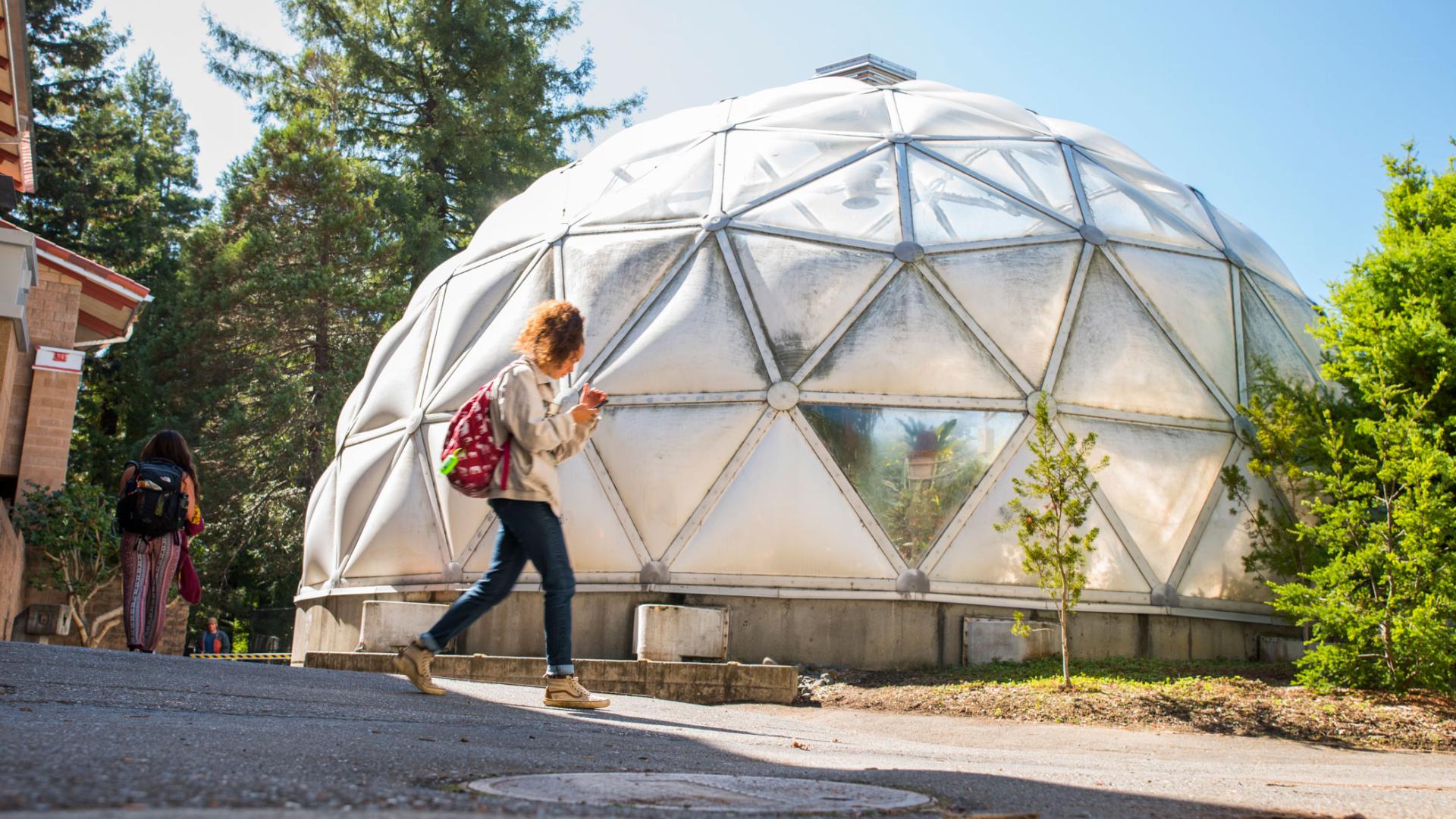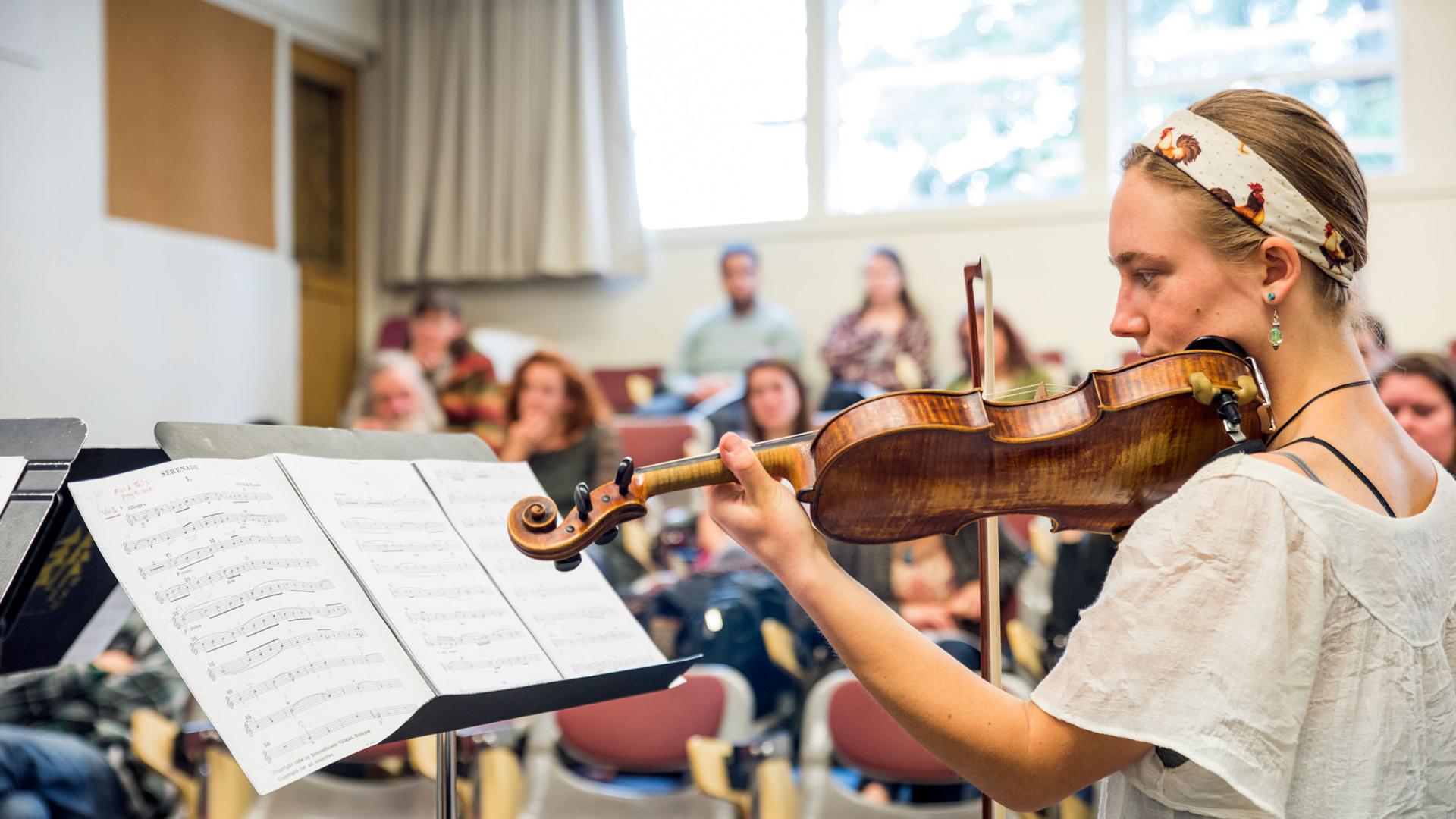Breadcrumb
Free Speech at Cal Poly Humboldt
Legacy of Activism
Engagement with social and political issues is woven into the fabric of Cal Poly Humboldt history. Open and respectful discourse continues to be an essential component of University life and the campus community is proudly committed to social justice and sustainability. Our activism has made meaningful changes not only on our campus and in our communities, but also in the world.
Cal Poly Humboldt unequivocally supports constitutionally protected rights of free expression and assembly, and the right to express opinions through speech and media.
Freedom of Expression vs. Civil Disobedience
While the first amendment does protect the right to free expression, please keep in mind that the Constitution does not guarantee any right to engage in civil disobedience — which, by its very definition, involves the violation of laws or regulations — without incurring consequences of said action. Even when performed in the pursuit of worthy causes, civil disobedience can have a negative effect on the protected interests of others. It might also interfere with University business, create a public safety concern, or endanger University assets. In these instances, the University may need to act to protect those interests.
For everyone to enjoy the freedom of expression there must be reciprocal respect for the rights of all individuals: the exercise of the rights granted by the First Amendment cannot interfere with others’ exercising their own rights. Please refer to the CSU's Systemwide Time, Place, and Manner policy as a guide for planning any demonstration on campus.
- The First Amendment to the United States Constitution provides that "Congress shall make no law respecting an establishment of religion, or prohibiting the free exercise thereof; or abridging the freedom of speech, or of the press; or the right of the people peaceably to assemble, and to petition the Government for a redress of grievances.
- Free Speech is defined by the California Constitution as "[e]very person may freely speak, write and publish his or her sentiments on all subjects, being responsible for the abuse of this right. A law may not restrain or abridge liberty of speech or press."
- The First Amendment requires that the government not discriminate against particular viewpoints. The Supreme Court has, however, upheld the idea that speech may be regulated under “Time, Place, and Manner” regulations. The burden of such regulations is still fairly high, requiring the government to show that their restrictions on speech are (1) content neutral (that the government does not outlaw content specific viewpoints), (2) narrowly tailored to serve a governmental interest (i.e., cannot be overly broad to regulate more than what is necessary to achieve government interest like, for example, public safety), and (3) ample alternative means to express ideas. At Cal Poly Humboldt, for example, the time, place, and manner regulations are a reflection of the value of encouraging diverse ideas, community engagement on campus, and academic freedom while also preserving interests including campus safety.
For more information about your First Amendment Rights, check out the ACLU’s guide on Free Speech on Campus.
Speech excluded from constitutional protection is speech that promotes an unlawful end such as;
- Promoting and incites imminent violence or harm
- Fighting words
- True threats
- Expression that constitutes criminal or severe harassment
- Severe, pervasive, and objectively offensive; AND
- Undermines and detracts from the victim’s educational experience; AND
- Results in the student being denied equal access to the institution’s resources and opportunities
- Defamation (e.g. libel and slander)
- Obscenity
- The use of public resources for partisan political activities
- False advertising
For policy clarification, please contact the Office of Student Rights and Responsibilities (located in Siemens Hall 211), call (707) 826-3504, or via email osrr@humboldt.edu.
A true threat is not protected by the First Amendment. The U.S. Supreme Court defined true threats in Virginia v. Black (2003) as “statements where the speaker means to communicate a serious expression of an intent to commit an act of unlawful violence to a particular individual or group of individuals.” According to the Supreme Court, true threats include when a speaker directs a threat to a person or group of persons with the intent of placing the victim in fear of bodily harm or death.
This definition means that expressions that may seem threatening may be protected, as only true threats where the speaker expresses intent to explicitly cause immediate harm are prohibited. An example of seemingly threatening expression that was protected occurred in Watts v. United States (1969), where the Supreme Court overturned Watts’ conviction for stating at an anti-war rally that: “I am not going. If they ever make me carry a rifle the first man I want to get in my sights is L.B.J.” The Supreme Court ruled that Watts’ language was not a true threat on the life of President Lyndon B. Johnson (L.B.J.), as Watts’ rhetoric was simply “political hyperbole.”
The First Amendment protects speech no matter how offensive it’s content. The courts have made clear that there is no “hate speech” exception to the 1st Amendment, and that no one has a right not to be offended by speech. Most “hate speech” is as fully protected as any other form of protected speech. One is as free to condemn Islam—or Muslims, Jews, African Americans, Caucasians, or undocumented immigrants—as one is to condemn capitalism, socialism, democrats or republicans. Restrictions on speech by public colleges and universities would be a violation of the Constitution and the equivalent to government censorship. (Office of General Counsel, 2016)
Tips for Recognized Student Organizations
- Review the CSU Systemwide Time, Place, and Manner Policy and the Humboldt Addendum and clarify related questions with the Office of Student Life at (707) 826-3776.
- Set a goal and purpose for your demonstration: Make sure all participating members of your club or organization understand the goal and intended outcome. Keep in mind that having a clear objective will make it easier for others to understand and support your cause.
- Develop a plan: Meet with the Director of Student Life or Associate Dean of Students to discuss logistics, location, speakers, safety, and other issues that will lead to a successful and safe event.
- Reserve a Venue: Reserve an appropriate venue through the process outlined with the Office of Student Life. Remember to utilize the CSU Systemwide Time, Place, and Manner Policy and the Humboldt Addendum along with other policies regarding amplification, use of public areas, and non-university speaker requirements.
- Confrontation: Before the event, meet with your members to discuss how they should respond in case they are confronted with offensive speech, counter protest, offensive behavior, or violence during your demonstration. During the event, REMEMBER: DO NOT RESPOND PHYSICALLY TO ANY CONFRONTATIONAL BEHAVIOR AND CONTACT UNIVERSITY POLICE. You can contact University Police via phone by dialing 911 or at (707) 826–5555.
- QUESTIONS? For support with or more information about this process, contact the Director of Student Life (Office of Student Life, 2nd floor, Gutswurrak Student Activities Center) at (707) 826-3776 or clubs@humboldt.edu, or the Office of Student Rights & Responsibilities (Siemens Hall 211) at (707) 826–3504 or osrr@humboldt.edu.
Tips for protests/demonstrations NOT facilitated by a Recognized Student Organization:
- Review the CSU Systemwide Time, Place, and Manner Policy and the Humboldt Addendum and clarify policy-related questions with the Office of Student Rights & Responsibilities by emailing osrr@humboldt.edu, call 707-826-3504, or visit the Dean of Students office in Siemens Hall 211.
- Set a goal and purpose for your demonstration: Make sure all participating members of your group understand the goal and intended outcome. Keep in mind that having a clear objective will make it easier for others to understand and support your cause.
- Develop a plan: Meet with the Associate Dean of Students to discuss logistics, location, speakers, safety, and other issues that will lead to a successful and safe event.
- Reserve a Venue: Reserve an appropriate venue with Conference & Event Services. Remember to utilize the Time, Place, and Manner regulations along with other policies regarding amplification, use of public areas, and non-university speaker requirements.
- Confrontation: Before the event, meet with your members to discuss how they should respond in case they are confronted with offensive speech, counter protest, offensive behavior, or violence during your demonstration. During the event, REMEMBER: DO NOT RESPOND PHYSICALLY TO ANY CONFRONTATIONAL BEHAVIOR AND CONTACT UNIVERSITY POLICE. You can contact University Police via phone by dialing 911 or at (707) 826–5555.
- Questions? For support with or more information about this process, contact the Office of Student Rights & Responsibilities (Siemens Hall 211) at (707) 826–3504 or osrr@humboldt.edu).
Recognized Student Organizations (RSOs)
RSOs that are non-compliant with University guidelines, regulations, policies and procedures, including but not limited to the system-wide TPM policy and Campus Addendum, may face a range of conduct violations and sanctions. RSOs are governed by this Handbook, which contains details regarding the student organization conduct process in Chapter 10. Actions to address RSOs that are non-compliant may include but are not limited to: educational programming/service, formal warning or reprimand, probation, suspension, limited or loss of organization privileges, and loss of university recognition. These actions are intended to correct non-compliance and promote a culture of accountability and adherence to University standards.
See the list of Cal Poly Humboldt’s Recognized Student Organizations and find additional details on our Clubs & Organizations website.
- Maintain a safe physical and social distance when engaging in free speech activities.
- Contact UPD if a physical altercation erupts or there is a threat of safety to anyone involved.
- Do not block entrances or restrict the free flow of traffic in and out of campus buildings, parking lots, campus roads, and walkways.
- Reserve spaces on campus (ex: University Quad or Balabanis Art Quad) to have your demonstration
- Avoid obstructing/disrupting campus activities, classes, and offices.
- Ask professors for an opportunity to speak about the event; should be before class begins or after class ends
- Amplification for scheduled events and demonstrations requires prior approval through the Dean of Students or their designee.
- Avoid disorderly or lewd conduct.
- Follow directives from University officials acting in the performance of their duties.
- Do not engage in theft, destruction of, or damage to any university property or equipment.
This section outlines potential violations of the California State University Student Code of Conduct. Violation of Time, Place, and Manner policy can lead to student conduct violations. This list is not exhaustive but meant to demonstrate examples of the interactions among free speech, policy, and student conduct.
All italicized sections are found in the California State University Student Code of Conduct
- Blocking of entrances to or otherwise restricting the free flow of traffic into and out of campus buildings, parking lots, campus roads and walkways with tables or movable stands:
(2) Unauthorized entry into, presence in, use of, or misuse of University property.
(4) Participating in an activity that substantially and materially disrupts the normal operations of the University, or infringes on the rights of members of the University community. - Obstructing or disrupting campus activities, classes, and offices:
(3) Willful, material and substantial disruption or obstruction of a University-related activity, or any on-campus activity.
(4) Participating in an activity that substantially and materially disrupts the normal operations of the University, or infringes on the rights of members of the University community. - Utilizing amplified sound that disrupts campus activities:
(3) Willful, material and substantial disruption or obstruction of a University-related activity, or any on-campus activity.
(4) Participating in an activity that substantially and materially disrupts the normal operations of the University, or infringes on the rights of members of the University community. - Engaging in physically and/or verbally abusive or threatening conduct toward any person. This includes the use of weapons or any item that maybe used as a weapon such as frozen water bottles, sticks, bats and anything that may be deemed as dangerous by University officials as well:
(7) Conduct that threatens or endangers the health or safety of any person within or related to the University community, including physical abuse, threats, intimidation, harassment, or sexual misconduct. - Exhibiting disorderly or lewd conduct. This includes disruptive behavior and/or disruption of a university activity.
(6) Disorderly, lewd, indecent, or obscene behavior at a University related activity, or directed toward a member of the University community. - Participating in a disturbance of the peace or unlawful assembly:
(4) Participating in an activity that substantially and materially disrupts the normal operations of the University, or infringes on the rights of members of the University community. - Failure to comply with a University official acting in the performance of their duties:
(17) Failure to comply with directions or, or interference with, any University official or any public safety officer while acting in the performance of his/her duties. - Engaging in theft, destruction of, or damage to any university property or equipment:
(11) Theft of property or services from the University community, or misappropriation of University resources.
(12) Unauthorized destruction, or damage to University property or other property in the University community.
The right to free speech—protected by the First Amendment—includes many rights, one of which is the right to speak, and another is the right to hear another’s speech if one wishes to do so. Individuals or groups may not suppress the speech of another individual by shouting down or otherwise drowning out or preventing the individual from being heard, otherwise known as a “heckler’s veto.” Besides being prohibited by law, a "heckler’s veto" is also prohibited by the CSU TPM policy.
Individuals may protest speakers on Campus with whom they disagree, but they may not do anything that prevents the speaker from expressing their views or prevents members in the audience from hearing or seeing the speaker. This prohibition also applies to the removal or erasure of written or printed expressive activities that are otherwise in compliance with the TPM policy and the Humboldt Addendum.
University staff who are confronted with a situation where a speaker cannot be heard because of an audience reaction will take steps to separate the two and ensure the safety of the speaker and the audience. If there is a true danger created from the conflict, steps must be taken to ensure the safety of all. However, shutting down the speaker or event will be avoided whenever possible.
Anonymous speech is expressive activity by one who has not disclosed their identity. The right to speak anonymously is protected, and the reason is to ensure that peaceful, lawful speech is not deterred because of fear that identification could lead to reprisal. This fear could result in less speech, and that could lead to issues of public importance not being discussed and debated. However, everyone on University property or in attendance at a University Activity is responsible for complying with applicable University policies, including CSU’s systemwide Interim Time, Place and Manner Policy.
Wearing masks or face coverings is permissible for all individuals who are complying with University policies and applicable laws. The University does not ask why a person may choose to wear a face covering. However, individuals on University property may not conceal their identity or refuse to provide identification for the purpose of evading identification when violating University policy or applicable law. In that case, an authorized University official, acting in an official capacity, may request identification. Failure to provide identification in that case is a violation of policy, and may also be a criminal violation.
Read CSU guidance on Anonymous Speech and Disguising Identity »
Reporting Guide for Addressing Issues of Concern and/or Filing Complaints at Cal Poly Humboldt University





